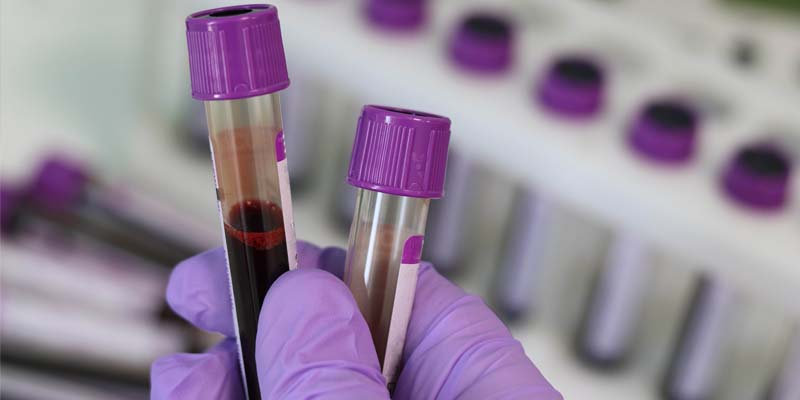*/

In courts across the UK blood alcohol testing is an essential part of the evidential picture, providing an insight into an individual’s alcohol consumption. In cases where the safeguarding of children and vulnerable people is paramount, such tests provide a rich source of information, enabling counsel to act on urgent welfare needs. But when it comes to blood alcohol tests, not all are created equal, with Phosphatidylethanol (PEth) testing providing the most conclusive insight into drinking patterns.
There are four main types of blood alcohol testing, all of which can provide us with a four-week historic overview of alcohol use:
Unlike CDT, LFT and MCV – all of which are indirect biomarkers of alcohol and whose presence can be affected by pre-existing medical conditions and medications, among other factors – PEth is a direct biomarker of alcohol. This means that it is only present in the body when alcohol has been consumed. An abnormal phospholipid, it requires ethanol for its production.
PEth production begins as soon as ethanol is consumed and accumulates in the blood with frequent alcohol consumption, giving it a high specificity (48-89%) and sensitivity (88-100%). Experiments show that PEth can be detected in blood after one to two hours, and for up to 12 days after a single drinking episode. In addition, daily alcohol consumption of more than 60g of ethanol (7.5 units) can clearly be distinguished from lower alcohol consumption. As such, PEth testing can detect chronic and single-drinking episodes.
The wealth of information provided by a PEth test, alongside its conclusiveness, is what makes it the most essential of all blood alcohol tests, enabling us to monitor abstinence, drinking behaviour, or identify relapse. PEth analysis is also the only blood alcohol test that can be undertaken during pregnancy or within two months of the birth.
In fact, recognition of the value of PEth testing is on the rise, with sales of such tests having more than doubled year-on-year among the legal profession (AlphaBiolabs sales data, 2020-21).
PEth is second only to the detection of ethyl glucuronide (EtG) and ethyl palmitate (EtPa): a fatty acid ethyl ester (FAEE) in the hair. Both EtG and EtPa are direct biomarkers of alcohol and give us a highly accurate insight into patterns of drinking, with a three- or six-month overview of usage. Each is absorbed into the hair via different routes, and their levels can assist in assessing excessive alcohol consumption.
EtG is water soluble, produced in the liver and can be impacted by various hair treatments including excessive washing. EtPa is formed in the sebaceous glands from ethanol diffusing from the blood circulation and then deposited into hair primarily from sebum (from the oil glands on the scalp). EtPa (FAEEs) are lipophilic so while not water soluble, its presence can be affected using alcohol-containing hair products such as sprays, gels, and wax.
Because of their respective strengths and weaknesses, both EtG and EtPA tests should be performed, and their findings used to support each other, as shown in LB Richmond v B & W & B & CB [2010] EWHC 2903 (Fam), where Mr Justice Moylan gave guidance on the evidential worth of hair strand testing. Within his guidance, it was also stressed that hair strand tests should not be used in isolation to reach evidential conclusions.
By performing these tests in conjunction with PEth and other blood tests, a more holistic conclusion can be drawn as to a person’s alcohol use.
Blood alcohol testing combined with hair testing provides us with the fullest picture from which to draw conclusions. This is especially important in family cases, where safeguarding children and vulnerable people is the highest priority. Using highly accurate scientific analysis and examining the way in which the body absorbs alcohol, a case can be made to protect those in need – and reunite families where abstinence has been achieved.

In courts across the UK blood alcohol testing is an essential part of the evidential picture, providing an insight into an individual’s alcohol consumption. In cases where the safeguarding of children and vulnerable people is paramount, such tests provide a rich source of information, enabling counsel to act on urgent welfare needs. But when it comes to blood alcohol tests, not all are created equal, with Phosphatidylethanol (PEth) testing providing the most conclusive insight into drinking patterns.
There are four main types of blood alcohol testing, all of which can provide us with a four-week historic overview of alcohol use:
Unlike CDT, LFT and MCV – all of which are indirect biomarkers of alcohol and whose presence can be affected by pre-existing medical conditions and medications, among other factors – PEth is a direct biomarker of alcohol. This means that it is only present in the body when alcohol has been consumed. An abnormal phospholipid, it requires ethanol for its production.
PEth production begins as soon as ethanol is consumed and accumulates in the blood with frequent alcohol consumption, giving it a high specificity (48-89%) and sensitivity (88-100%). Experiments show that PEth can be detected in blood after one to two hours, and for up to 12 days after a single drinking episode. In addition, daily alcohol consumption of more than 60g of ethanol (7.5 units) can clearly be distinguished from lower alcohol consumption. As such, PEth testing can detect chronic and single-drinking episodes.
The wealth of information provided by a PEth test, alongside its conclusiveness, is what makes it the most essential of all blood alcohol tests, enabling us to monitor abstinence, drinking behaviour, or identify relapse. PEth analysis is also the only blood alcohol test that can be undertaken during pregnancy or within two months of the birth.
In fact, recognition of the value of PEth testing is on the rise, with sales of such tests having more than doubled year-on-year among the legal profession (AlphaBiolabs sales data, 2020-21).
PEth is second only to the detection of ethyl glucuronide (EtG) and ethyl palmitate (EtPa): a fatty acid ethyl ester (FAEE) in the hair. Both EtG and EtPa are direct biomarkers of alcohol and give us a highly accurate insight into patterns of drinking, with a three- or six-month overview of usage. Each is absorbed into the hair via different routes, and their levels can assist in assessing excessive alcohol consumption.
EtG is water soluble, produced in the liver and can be impacted by various hair treatments including excessive washing. EtPa is formed in the sebaceous glands from ethanol diffusing from the blood circulation and then deposited into hair primarily from sebum (from the oil glands on the scalp). EtPa (FAEEs) are lipophilic so while not water soluble, its presence can be affected using alcohol-containing hair products such as sprays, gels, and wax.
Because of their respective strengths and weaknesses, both EtG and EtPA tests should be performed, and their findings used to support each other, as shown in LB Richmond v B & W & B & CB [2010] EWHC 2903 (Fam), where Mr Justice Moylan gave guidance on the evidential worth of hair strand testing. Within his guidance, it was also stressed that hair strand tests should not be used in isolation to reach evidential conclusions.
By performing these tests in conjunction with PEth and other blood tests, a more holistic conclusion can be drawn as to a person’s alcohol use.
Blood alcohol testing combined with hair testing provides us with the fullest picture from which to draw conclusions. This is especially important in family cases, where safeguarding children and vulnerable people is the highest priority. Using highly accurate scientific analysis and examining the way in which the body absorbs alcohol, a case can be made to protect those in need – and reunite families where abstinence has been achieved.


Now is the time to tackle inappropriate behaviour at the Bar as well as extend our reach and collaboration with organisations and individuals at home and abroad
A comparison – Dan Monaghan, Head of DWF Chambers, invites two viewpoints
And if not, why not? asks Louise Crush of Westgate Wealth Management
Marie Law, Head of Toxicology at AlphaBiolabs, discusses the many benefits of oral fluid drug testing for child welfare and protection matters
To mark International Women’s Day, Louise Crush of Westgate Wealth Management looks at how financial planning can help bridge the gap
Casey Randall of AlphaBiolabs answers some of the most common questions regarding relationship DNA testing for court
Maria Scotland and Niamh Wilkie report from the Bar Council’s 2024 visit to the United Arab Emirates exploring practice development opportunities for the England and Wales family Bar
Marking Neurodiversity Week 2025, an anonymous barrister shares the revelations and emotions from a mid-career diagnosis with a view to encouraging others to find out more
David Wurtzel analyses the outcome of the 2024 silk competition and how it compares with previous years, revealing some striking trends and home truths for the profession
Save for some high-flyers and those who can become commercial arbitrators, it is generally a question of all or nothing but that does not mean moving from hero to zero, says Andrew Hillier